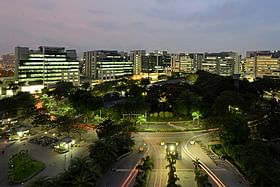Several companies operating across varied service segments, including start-ups, have found its office space needs in the workspace setup of Navi Mumbai.
The Maharashtra government has issued a government resolution (GR) on 17 February 2023, permitting centres of service sector on 85 per cent of the land of Navi Mumbai Integrated Industrial Township, reports Hindustan Times.
The region earlier known as Navi Mumbai Special Economic Zone (NMSEZ) is promoted by state-owned City and Industrial Development Corporation (CIDCO) and Reliance Group.
In 2018, the state government approved the proposal to convert the NMSEZ into Navi Mumbai Integrated Industrial Township (NMIIT), following the 2013 industrial policy of Maharashtra.
It was also decided that industrial units and residential projects should progress in proportion of 85 per cent and 15 per cent.
This development is set to advance the state government’s plans to transform NMIIT into the new centre for information technology (IT) and service sectors in Maharashtra — supported by the opportunities of the ongoing infrastructure development focused on growth of the planned city.
Along with setting up of IT centres, the government additionally intends to encourage establishment of educational, research, medical and knowledge centres in the region.
State’s Vision For Navi Mumbai
The additional chief secretary (urban development), Bhushan Gagrani said, “Navi Mumbai has an ecosystem for the IT sector and service sector. The area will be connected to national and international destinations through the upcoming international airport and will be easily accessible from Mumbai once Mumbai Trans Harbour Link (MTHL) is completed.
“So to boost economic growth and develop a service sector hub for next-generation IT and allied services, the government has allowed the service sector on the land of NMIIT,”
Earlier, Maharashtra’s Deputy Chief Minister, Devendra Fadnavis, during the NASSCOM Technology and Leadership Forum, held in Mumbai, spoke about how high rentals and cost of living made Mumbai unaffordable over the years for companies and businesses to stay.
Realising these factors, he further added that the Chief Minister Eknath Shinde-led government is creating infrastructure that will help Mumbai regain its lost ground.
The Maharashtra government is working on building several data centres, within which 65 per cent of India’s data capacity is planned to be developed in Navi Mumbai.
Navi Mumbai To Offer Development For IT And Fintech
Spread over an area of 344 square kilometres, Navi Mumbai was developed as a planned city in the expanse of Mumbai, to decongest the mainland.
Over the past two decades, the city has undergone a significant transformation and has emerged as a key growth driver in the Mumbai metropolitan region (MMR).
The planned developments have attracted numerous investments, and the city now houses both commercial and residential setups with affordable options, as well as improved transit connectivity.
The several infrastructure initiatives that are ongoing around Navi Mumbai are aimed to enhance the connectivity and development in the region.
Of these, the major developments include the Navi Mumbai International Airport (NMIA), which is being designed to cater to about 60 million passengers and 1.5 million tonnes of cargo annually.
Upon completion, CIDCO predicts that the airport is projected to have a major impact on the city’s land market for the domestic and international service sectors, and will aid in generating over 400,000 direct and indirect jobs.
Similarly, the 21.8-km-long Mumbai trans harbour link, developed to significantly reduce the commute time from Navi Mumbai to south Mumbai, will support the regional connectivity.
With a focus on enhancing the regional connectivity, the state government is implementing the Navi Mumbai metro rail project from CBD Belapur to Pendhar, which is being developed with an estimated cost of Rs 3,063.63 crore for easy and quality transit commute within the city.
Building on these advancements, coupled with the features such as large land banks, easier land acquisition, proximity to the sea for cable landing and the ability to meet electricity needs — the city is fast becoming the preferred destination for IT and data centres.
As a result, centre operators are exploring opportunities in campus developments and independent sites for offices and corporate parks within the city.
Several companies operating across varied service segments, including start-ups, have found its office space needs in the workspace setup of Navi Mumbai.
During 2021, approximately 67,000 square feet of office space was leased by flexible workspace operators in Navi Mumbai, garnering about 11 per cent share of office leasing in the region.
The government’s favourable policy changes, along with the availability of developable land, emphasis on quality of living, an attractive location with low office rents, and a large pool of employees in the vicinity — has positioned Navi Mumbai for the next level of growth as the inflow of investments is expected to rise in the coming future.


